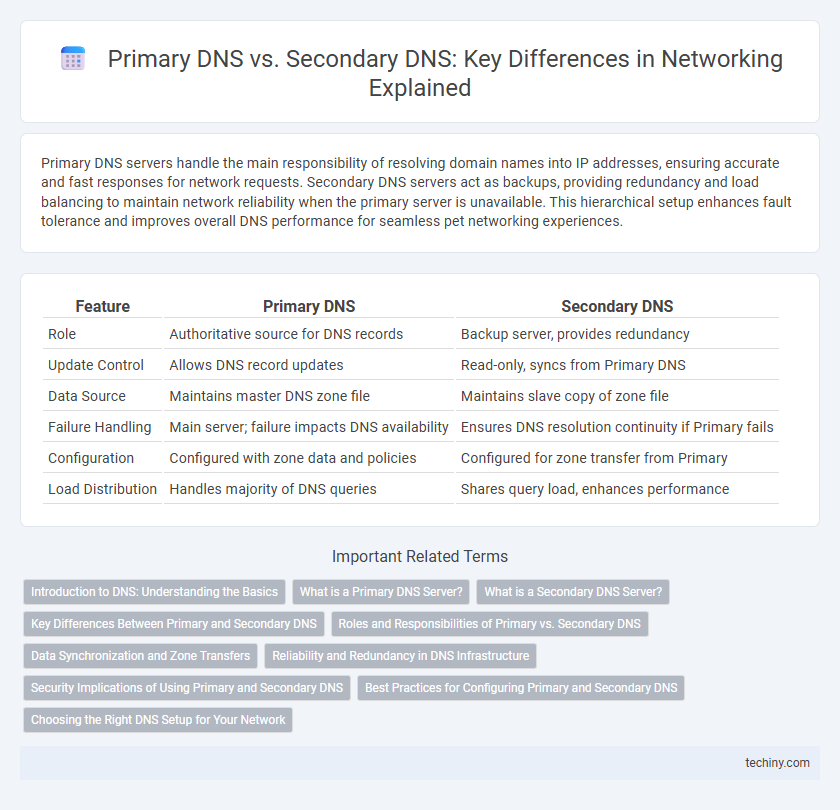Primary DNS servers handle the main responsibility of resolving domain names into IP addresses, ensuring accurate and fast responses for network requests. Secondary DNS servers act as backups, providing redundancy and load balancing to maintain network reliability when the primary server is unavailable. This hierarchical setup enhances fault tolerance and improves overall DNS performance for seamless pet networking experiences.
Table of Comparison
| Feature | Primary DNS | Secondary DNS |
|---|---|---|
| Role | Authoritative source for DNS records | Backup server, provides redundancy |
| Update Control | Allows DNS record updates | Read-only, syncs from Primary DNS |
| Data Source | Maintains master DNS zone file | Maintains slave copy of zone file |
| Failure Handling | Main server; failure impacts DNS availability | Ensures DNS resolution continuity if Primary fails |
| Configuration | Configured with zone data and policies | Configured for zone transfer from Primary |
| Load Distribution | Handles majority of DNS queries | Shares query load, enhances performance |
Introduction to DNS: Understanding the Basics
Primary DNS servers store original zone files and handle updates directly from the domain administrator, ensuring authoritative responses for DNS queries. Secondary DNS servers maintain read-only copies of the zone files obtained via zone transfers, providing redundancy and load balancing in the DNS infrastructure. This distinction enhances DNS reliability and availability by distributing query loads and preventing single points of failure.
What is a Primary DNS Server?
A Primary DNS server is the authoritative source for a domain's DNS records, responsible for storing and managing the original zone files. It handles all updates and changes made to the DNS data, ensuring accurate resolution of domain names to IP addresses. This server distributes the DNS information to Secondary DNS servers, which provide redundancy and load balancing.
What is a Secondary DNS Server?
A Secondary DNS server is a backup server that holds a read-only copy of the DNS zone data from the Primary DNS server, ensuring continuity and load distribution in domain name resolution. It regularly updates its records through zone transfers, maintaining synchronization with the Primary DNS to prevent service disruptions during outages. Secondary DNS servers enhance network reliability and improve fault tolerance by providing redundancy in DNS infrastructure.
Key Differences Between Primary and Secondary DNS
Primary DNS servers host the original read-write zone files and handle all updates and changes to DNS records, ensuring authoritative responses for a domain. Secondary DNS servers maintain read-only copies of the zone files by regularly synchronizing with the primary server through zone transfers, providing redundancy and load balancing. The key difference lies in their roles: primary DNS manages and edits DNS records, while secondary DNS serves as a backup to improve fault tolerance and reliability in the domain name system.
Roles and Responsibilities of Primary vs. Secondary DNS
Primary DNS servers hold the authoritative zone data, managing updates and changes to DNS records directly, which ensures accurate and current domain information. Secondary DNS servers function as read-only replicas, retrieving zone data through zone transfers from the primary server to provide redundancy and load balancing. This division enhances reliability by distributing DNS query loads and maintaining uninterrupted domain name resolution during primary server outages.
Data Synchronization and Zone Transfers
Primary DNS servers host the original read-write copy of zone data, ensuring authoritative updates and management. Secondary DNS servers obtain synchronized read-only copies of the zone through zone transfers, typically using AXFR or IXFR protocols to replicate data efficiently. Reliable synchronization between primary and secondary DNS enhances redundancy, load distribution, and fault tolerance across distributed network environments.
Reliability and Redundancy in DNS Infrastructure
Primary DNS servers host the original zone files and handle all DNS queries initially, ensuring authoritative responses for domain resolution. Secondary DNS servers obtain copies of zone data through zone transfers, providing redundancy and load balancing in case the primary server fails or becomes unreachable. This setup enhances DNS infrastructure reliability by minimizing downtime and maintaining continuous domain name resolution services.
Security Implications of Using Primary and Secondary DNS
Using both primary and secondary DNS servers enhances network resilience by providing redundancy, reducing the risk of service disruption due to DNS spoofing or denial-of-service attacks. Primary DNS servers handle the main query load, while secondary DNS servers act as backups, limiting exposure to DNS cache poisoning by distributing query traffic. Proper synchronization and security measures, such as DNSSEC implementation on both servers, are critical to prevent attackers from exploiting vulnerabilities in either DNS server.
Best Practices for Configuring Primary and Secondary DNS
Configuring Primary DNS and Secondary DNS requires ensuring the primary DNS server holds the master copy of the DNS zone and that secondary DNS servers synchronize regularly through zone transfers to maintain up-to-date records. Best practices include implementing secure zone transfers using TSIG keys, distributing secondary servers geographically to enhance redundancy, and monitoring DNS server logs to detect and prevent potential spoofing or denial-of-service attacks. Regular testing of DNS failover mechanisms improves network resilience and minimizes downtime during primary server outages.
Choosing the Right DNS Setup for Your Network
Selecting the right DNS setup involves understanding the roles of Primary DNS, which handles direct domain name resolution and configuration, while Secondary DNS serves as a backup to ensure continuity in case the primary server fails. Implementing a Secondary DNS enhances network reliability by distributing DNS query loads and providing redundancy against downtime. For optimal performance and security, choose a setup that balances responsiveness, failsafe mechanisms, and geographic distribution based on your network's size and criticality.
Primary DNS vs Secondary DNS Infographic

 techiny.com
techiny.com